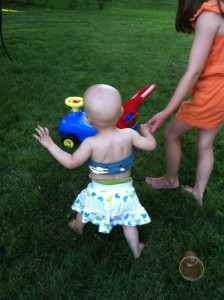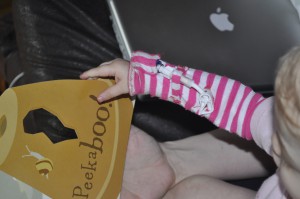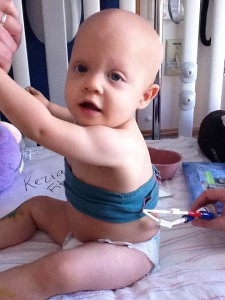
Saoirse Fitzgerald taking a walk wearing her CareAline wrap. The wrap, designed by her mother, helped keep her central line secure. (Mike & Kezia Fitzgerald)
Over the last year and a half I’ve written 70-plus stories about innovations by doctors, nurses and other staff at Boston Children’s Hospital. I haven’t yet written a story about a patient innovation. But that doesn’t mean that patients and their families aren’t out there innovating.
Case in point: Kezia Fitzgerald saw pretty quickly that there was a problem she might be able to fix. Her daughter Saoirse (pronounced Seer-sha), who had been diagnosed with neuroblastoma, had just had a PICC line put into her arm at Dana-Farber/Children’s Hospital Cancer Center to infuse drugs and fluids. Within a day, Saoirse was tugging at the line, trying to pull off the tape that was keeping it in place. “It was irritating her skin pretty badly,” Kezia says. “She was really uncomfortable.”
Kezia, herself at the time fighting Hodgkin lymphoma (read the family’s story on our sister blog, Thriving), wanted to make her daughter as comfortable as she could. “I pulled out my sewing machine and some cotton fabric,” Kezia recalls, “and made this little sleeve with a pocket that I thought could hold the line in place without having to tape it to her skin.”
That, in a nutshell, is the origin story of the CareAline, which Kezia and her husband Mike are developing into a product that they hope will make life a little easier for patients young and old with cancer and other chronic illnesses.
The CareAline is a band of stretchable cloth sewn as either a sleeve (for the arm) or wrap (for the chest), with a hole and a pocket for a PICC or central line. (Kezia designed the chest version when Saoirse’s PICC line was replaced with a central line.) You slip the band on, slide the end of the catheter out of the hole and connect it—or,if it’s not connected at the time, store it in the pocket. That’s it. If the band gets dirty, it can go right in the wash.
When we put the sleeve on Saoirse the first time,” Kezia says, “she completely forgot about the line. Didn’t tug on it all. Didn’t even remember that it was there.”
The CareAline was a popular item on the Boston Children’s inpatient oncology unit on 6 North during Saoirse’s time there. “When the girl in the next room noticed Saoirse wearing the wraps, she asked if we could make one for the line in her arm,” Kezia says. “Soon nurses on the floor were showing it to other families, and they started asking too.”
“Families are always asking for ways to help keep their child’s lines secure,” says Marnie Salkovitz, RN, BSN, who was part of Saoirse’s care team. “The lines dangle, sometimes from the chest down below the waist for central lines. And the children sometimes try to pull or even chew on them.
“I was very impressed when Kezia showed me the wrap, both with how it looked and how it worked,” she continues. “It helped make my job easier as a nurse.”
Sadly, Saoirse lost her battle with cancer last winter. “It’s been a tough time for the family,” says Mike. “When both Kezia and Saoirse were diagnosed, we were facing dual cancer diagnoses, two treatment schedules and complete upheaval of our lives. Since losing Saoirse, we’ve realized that we could either give in to our grief, or try to work through and hopefully do something that can help other children and grown-ups with cancer.”
The family has now gone through several different wrap and sleeve designs, has filed for a patent and is building a business to commercialize them.
“We think the CareAline could help reduce the stress patients, families and caregivers feel about line safety,” Mike says. “We also think it might help reduce infection risk, because patients’ skin wouldn’t get irritated by tape while wearing it and the pocket will help keep the end of the catheter secure and away from dirt.”
“It’s great to see innovation like this coming from patients,” says Nurjana Bachman, PhD, of Boston Children’s Technology and Innovation Development Office. “We’re used to seeing our doctors and nurses be the innovators, and sometimes it’s the families who, based on their own care experiences, have the best ideas.”
Can you think of other examples of products, designs or innovations developed by patients and their families to make the lives of people in treatment better? Share them in the comments, on our Facebook page, or by tweeting us (@science4care).









